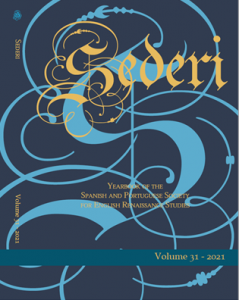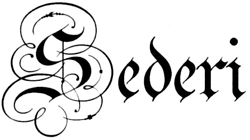
Sederi 30
Sederi 31 — 2021
EDITOR
Ana Sáez-Hidalgo
MANAGING EDITORS
Marta Cerezo Moreno
Isabel Guerrero Llorente
REVIEW EDITOR
Miguel Ramalhete
ISSN 1135-7789
Henk, Antony. “Mending ‘the injurie of oblivion’: ‘Englishing’ Chaucer and Barbour in early printed editions.” SEDERI 31 (2021): 31–46.
DOI: https://doi.org/10.34136/sederi.2021.2 Download PDF
Abstract
This article examines the editorial choices made in Edinburgh printer Andro Hart’s 1616 edition of John Barbour’s Brus. Comparison of the 1616 Hart edition with Thomas Speght’s 1602 Chaucer edition displays similar concerns with preserving accessibility to historical texts despite significant language changes in both Older Scots and English, noting shared employment of assistive paratextual apparati. Linguistic assessment comparing Hart and Speght’s editions to their parent texts demonstrates how both editors modernize language to improve reader accessibility while preserving archaic qualities and metricality. Contextualization of the declining prestige of Older Scots during the sixteenth and seventeenth centuries further clarifies this assessment. Hart’s edition portrays both a genesis of mutual intelligibility between Scots and English, and a coda for Older Scots as a literary prestige tongue.
Keywords: Older Scots; Thomas Speght; Scottish printing; Early Modern printing; Anglicization.
References
Barbour, John. 1616. The Actes and Life of the most Victorious Conquerour, Robert Bruce, King of Scotland. Edinburgh: Andro Hart. STC (2nd ed.) / 1378. Accessed 31 Aug. 2021. https://www.english-corpora.org/eebo/
Barbour, John. 1907. The Bruce, Being the Metrical History of Robert the Bruce, King of Scots. Translated by George Eyre-Todd. London: Gowans & Grey Limited. Accessed 29 Aug. 2021.
https://electricscotland.com/history/bruce1.htm.
Barbour, John. 1909. The Bruce. Edited by W.M. Mackenzie. London: Adam and Charles Black.
Barbour, John. 1980. Barbour’s Bruce. Edited by Matthew P. McDiarmid and James A. C. Stevenson, 3 vols. Edinburgh: Scottish Text Society.
Chaucer, Geoffrey. 1598. The Workes of our Antient and Lerned English Poet, Geffrey Chaucer, Newly Printed. Edited by Thomas Speght et al. London: Adam Islip [impensis Geor. Bishop]. STC (2nd ed.) 5077. Accessed 27 Aug. 2021. https://www.english-corpora.org/eebo/.
Chaucer, Geoffrey. 1602. The Vvorkes of our Ancient and Lerned English Poet, Geffrey Chaucer, Newly Printed. Edited by Thomas Speght et al. London: Adam Islip [impensis Geor. Bishop]. STC (2nd ed.) 5081. Accessed 27 Aug. 2021. https://www.english-corpora.org/eebo/.
Chaucer, Geoffrey. 2013. The Multitext Edition. The Norman Blake Editions of The Canterbury Tales. Edited by Estelle Stubbs et al. University of Sheffield. Accessed 27 Aug. 2021. http://www.chaucermss.org/multitext.
Hart 1616. See Barbour, John 1616.
Speght 1598; 1602. See Chaucer, Geoffrey 1598; 1602.
Secondary sources
Aitken, A. J. 2015a. “A History of Scots.” Collected Writings on the Scots Language, edited by Caroline Macafee. Scots Language Centre. Accessed 27 July 2021.
https://d3lmsxlb5aor5x.cloudfront.net/library/document/aitken/A_History_of_Scots.pdf.
Aitken, A. J. 2015b. “How to Pronounce Older Scots.” Collected Writings on the Scots Language, edited by Caroline Macafee. Scots Language Centre. Accessed 27 July 2021.
https://d3lmsxlb5aor5x.cloudfront.net/library/document/aitken/How_to_pronounce_Older_Scots.pdf.
Aitken, A. J. 2015c. “The Pioneers of Anglicised Speech in Scotland; a Second look.” Collected Writings on the Scots Language, edited by Caroline Macafee. Scots Language Centre. Accessed 27 July 2021. https://d3lmsxlb5aor5x.cloudfront.net/library/document/aitken/The_Pioneers_of_anglicised_speech_in_Scotland.pdf.
Aitken, A. J. 2015d. “Variation and Variety in Written Middle Scots.” Collected Writings on the Scots Language, edited by Caroline Macafee. Scots Language Centre. Accessed 27 July 2021. https://d3lmsxlb5aor5x.cloudfront.net/library/document/aitken/Variation_and_variety_in_written_Middle_Scots.pdf.
Bald, Marjory A. 1926. “The Anglicisation of Scottish Printing.” The Scottish Historical Review 23, no. 90: 107–115.
Bald, Marjory A. 1927. “The Pioneers of Anglicised Speech in Scotland.” The Scottish Historical Review 24, no. 95: 179–193.
Baugh, Albert C., and Thomas Cable. 2002. A History of the English Language. London: Routledge.
Bishop, Louise M. 2007. “Father Chaucer and the Vivification of Print.” The Journal of English and Germanic Philology 106, no. 3: 336–363.
Blakeway, Amy. 2016. “‘Newes from Scotland’ in England, 1559–1602.” Huntington Library Quarterly 79, no. 4: 533–559.
Bly, Siobhan. 1999. “From Text to Man: Re-Creating Chaucer in Sixteenth Century Print Editions.” Comitatus: A Journal of Medieval and Renaissance Studies 30, no. 1: 131–165.
Jack, R. D. S. 1988. “Poetry under King James VI.” In The History of Scottish Literature. Vol. 1, Origins to 1660, edited by C. Cairns, 125–140. Aberdeen: Aberdeen University Press.
Kinney, Clare R. 1998. “Thomas Speght’s Renaissance Chaucer and the Solaas of Sentence in Troilus and Criseyde.” In Refiguring Chaucer in the Renaissance, edited by Theresa M. Krier, 66–84. Gainesville: University Press of Florida.
Lawson-Peebles, Robert. 2016. “A Conjoined Commonwealth: The Implications of the Accession of James VI and I.” The Yearbook of English Studies 46, Writing the Americas, 1480–1826 (special issue): 56–74.
Machan, Tim William. 1995. “Speght’s ‘Workes’ and the Invention of Chaucer.” Text 8: 145–170.
Mann, Alastair J. 2000. The Scottish Book Trade: 1500–1720. East Linton: Tuckwell Press.
Mann, Alastair J. 2001. “The Anatomy of the Printed Book in Early Modern Scotland.” The Scottish Historical Review 80, no. 210, part 2: 181–200.
Mann, Alastair J. 2004. “A Spirit of Literature—Melville, Ballie, Wodrow, and a Cast of Thousands: The Clergy in Scotland’s long Renaissance.” Renaissance Studies 18 (1): 90–108.
Mason, Roger A. 2013. “Certeine Matters Concerning the Realme of Scotland: George Buchanan and Scottish Self-Fashioning at the Union of the Crowns.” The Scottish Historical Review 92, no. 233, part 1: 38–65.
Menzer, Melinda J. 2000. “Dialogue: Conservative and Advanced Speakers.” The Great Vowel Shift. Accessed 27 July 2021. http://facweb.furman.edu/~mmenzer/gvs/dialogue.htm.
Pearsall, Derek. 1984. “Thomas Speght (ca. 1550–?).” In Editing Chaucer: The Great Tradition, edited by Paul G. Ruggiers, 71–92. Norman, OK: Pilgrim Books.
Pearsall, Derek. 2004. “John Stow and Thomas Speght as Editors of Chaucer: A Question of Class.” In John Stow (1525–1605) and the Making of the English Past: Studies in Early Modern Culture and the History of the Book, edited by Ian Gadd and Alexandra Gillespie, 119–125. London: British Library.
Smith, Jeremy. 2013. “Textual Afterlives: Barbour’s Bruce and Hary’s Wallace.” In Scots: Studies in its Literature and Language, edited by John M. Kirk and Iseabail Macleod, 37–69. Amsterdam: Rodopi.
Trigg, Stephanie. 2008. “The Injuries of Time: Geoffrey Chaucer, Thomas Speght and Wade’s Boat.” The La Trobe Journal 81: 106–117. Accessed 27 July 2021. http://www3.slv.vic.gov.au/latrobejournal/issue/latrobe-81/t1-g-t9.html.
Wormald, Jenny. 1991. Kirk, Court, and Community: Scotland, 1470–1625. Edinburgh University Press.
